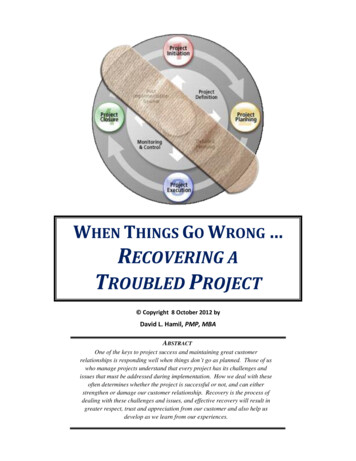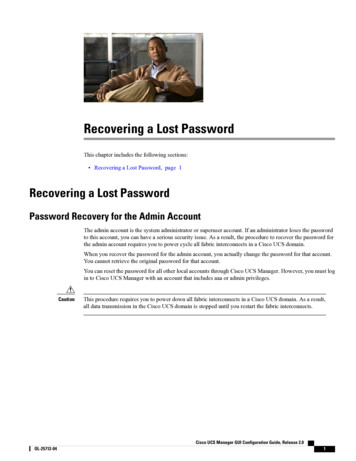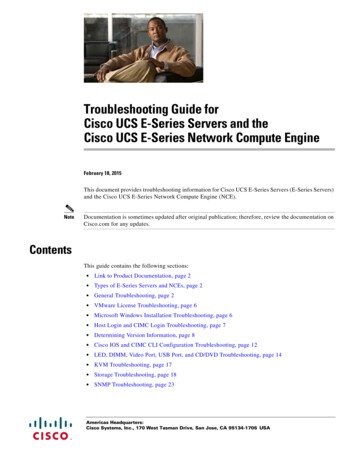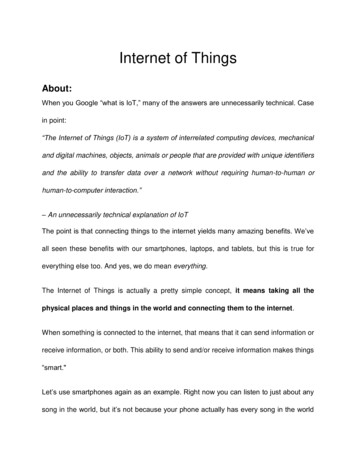
Transcription
WHEN THINGS GO WRONG RECOVERING ATROUBLED PROJECT Copyright 8 October 2012 byDavid L. Hamil, PMP, MBAABSTRACTOne of the keys to project success and maintaining great customerrelationships is responding well when things don’t go as planned. Those of uswho manage projects understand that every project has its challenges andissues that must be addressed during implementation. How we deal with theseoften determines whether the project is successful or not, and can eitherstrengthen or damage our customer relationship. Recovery is the process ofdealing with these challenges and issues, and effective recovery will result ingreater respect, trust and appreciation from our customer and also help usdevelop as we learn from our experiences.
When Things Go Wrong Recovering a Troubled ProjectINTRODUCTIONThe statistics regarding troubled projects are sobering. According to a survey conductedby Project Management Solutions (PM Solutions), firms on average manage 200 millionin projects each year; and, in the course of that year, these organizations will realize thatmore than a third of their projects - 74 million worth – are at risk of failing1. Jobs, andmaybe the business itself, may be in jeopardy if nothing is done to mitigate the risks andactively attempt to recover these troubled projects.PM Solutions’ research shows that when organizations take actions to recover troubledprojects, they are highly successful. Almost three quarters (74%) of the troubled projectsthat underwent recovery intervention in the past three years were recovered. In addition,18% of these projects have recovery efforts that are still ongoing; the successfulcompletion of these projects should boost the percentage of recovered projectssubstantially1.Those of us who manage projects understand that every project has its challenges andissues that must be addressed during implementation. How we deal with these oftendetermines whether the project is successful or not, and can either strengthen or damageour customer relationship.One of the keys to project success and maintaining great customer relationships isresponding well when things don’t go as planned. Recovery is the process of dealingwith the challenges and issues we face within our projects, and effective recovery willresult in greater respect, trust, and appreciation from our customer and also help usdevelop as we learn from our experiences.It is for these reasons that this paper was written. Over the discourse of this paper,answers to the following questions will be addressed with the purpose to navigate anactive, implementation (non-production) project from a state of chaos to-and-through thecrisis situation into a calmed state of normalcy: Do we really know if we have a troubled project on our hands? Who should lead the project recovery effort? What are the characteristics and expectations of the project stakeholders during acrisis? What are the top steps to project recovery? How do you know when you have achieved project recovery?Page 2 of 14
When Things Go Wrong Recovering a Troubled ProjectWhat’s the Project Situation?Before we identify a project that is in a state of chaos or in a crisis situation, let’sexamine some essential criteria for detecting a failing or troubled project across thevarious competing project constraints (CPC) 2 and project success factors (PSF), whereone or more of the following criteria apply:Table 1. Some Symptoms of Failing and Troubled Projects across CPCs & PSFsCPC / PSFStatusFinancialFailingDescriptionActual costs have exceeded estimated budget, includingany acceptable variancesFailing / There is a high probability risk that the project will fallTroubled short of expected profitability; return on investmentTroubled The project is expected to exceed the budget atcompletion by more than an acceptable percentage (e.g.,10%)ScopeFailingThere is a significant miss-alignment in products and/orservices with customer expectationsFailing / The number of work hours is exceeding budgeted hoursTroubled by a significant percentageTroubled The number of approved scope changes exceeds a giventhreshold.ScheduleFailingTasks in the critical path for a milestone, subproject orentire project are behind schedule, and the forecast is tobe unacceptably behind schedule at anticipatedcompletionTroubled There are significant gaps (e.g., greater than 5% overplan) between planned and actual milestone dates orcompleted deliverables, or there are no establishedmilestone dates. I.e., critical issues in meeting orcompleting milestones, on timeQualityFailingOverall quality is not acceptableTroubled The number of technical issues are critical and/orsignificantly growingCustomerRelationshipTroubled The project team has a poor working relationship with thecustomer and/or the working relationship is rapidlydecliningROVFailing / There is a high probably risk that project will not deliveryTroubled anticipated benefits; return on valueIn almost every case, a troubled project exhibits classic warning signs (i.e., symptoms)such as those shown in Table 1. There are, however, some more subtle symptoms that aPage 3 of 14
When Things Go Wrong Recovering a Troubled Projectproject is in trouble that might not glowingly stand out to the casual observer. These,more subtle warning signs, are shown in the table below3:Table 2. Subtle Signs of Troubled ProjectsPerpetual Green Lights but Little Activity:Many of you are familiar with the approach of labeling projects when they are onschedule, budget, etc.; yellow when the project is falling behind; and red when the projectis far behind and/or over-budget and/or having quality problems. Perhaps your keyproject has been reporting green for last three months but oddly there’s been very littleactivity related to the project. This is a good indication that the project is actually introuble.Troubling Trends:Experienced project managers (PMs) are familiar with using techniques like earnedvalue management (EVM) to identify project progress by comparing actual to plannedresults for work completed, costs incurred and time spent. Though you may not be usingEVM on your projects, you can watch for dramatic increases or drops in spending,dramatic changes to work being delivered or sudden changes in schedule with no new(approved) schedule dates. Such troubling trends are a sign your project is in trouble.Lots of TBDs:Effective risk and issue management, and follow-up on action items are critical to thesuccess of our projects, yet may be ignored. If your project is well past the early stagesbut is reporting a lot of To Be Determined (TBDs) in the “Resolution” column for risks,issues and actions, then it’s probably a troubled project, even if the schedule does notshow it.Non-Progress Reports:You’re wise so you ask your PM to provide status reports on a weekly basis. However,they’re more like “Non-Progress” reports than progress reports because no progress hasbeen made. In particular, if you’ve received two or more weekly status reports indicatingno progress has been made (with no explanation), you’re well on your way to having atroubled project on your hands, if you don’t already.Inability to Show Tangible Results:Anyone from Missouri? If no, as management or PMs we should at least adopt theirunofficial slogan as the “Show-Me” state in your everyday “walk.” Synonymous withthis phrase, “I’m from Missouri,” which means “I’m skeptical of the matter and not easilyconvinced.” As leaders, we should be skeptical – not be a push-over – and ask thoseleading or drill-down questions to have the team show you and me those tangible resultson a periodic basis. The absence there, one can assume like the Non-Progress Reportsthat no progress is being made and we have trouble on our hands. This especially so ifwe’ve moved beyond the date when such progress should be evident.To the enlightened or seasoned practitioner, a project is in a state of normalcy if the CPCslike scope, schedule, budget, and quality are all in check.“Chaos,” according to the online Merriam-Webster dictionary, is the state of things whenchance is supreme” or the inherent unpredictability in the outcome of a situation, event orPage 4 of 14
When Things Go Wrong Recovering a Troubled Project[project, in our case]4. The term chaos is synonymous with confusion, disorder,disorganization, havoc, and mess to name several.A project is in a state of chaos when: The team and/or senior management is oblivious to the situation at hand, or The team is aware of the situation but does not plan-then-act to recover thetroubled project, orThe recovery efforts are ineffective and the project is still in a mess. Regardless, this is a “Houston, we still have a problem” type of situation.“Crisis,” according to the dictionary, is a turning point (for better or for worse), adecisive moment, or an unstable or crucial time or state of affairs in which a decisivechange is impending5. The term crisis is synonymous with an emergency, crunch time,and zero hour to name several.A project in a state of crisis is not necessarily a bad thing: if in the case where it hastransitioned from a state of chaos then we’re headed in the right direction. On the flipside, it is not a good thing if we’re now in an emergency situation after having been in astate of normalcy. Regardless, a crisis is heightened; defining moment for the projectwhere the situation should be improved if the recovery efforts of both people andprocesses are effective. The absence thereof, we’re likely on a free-fall trajectory towarda chaotic situation.Let’s assume the following: A project review has been conducted and we have identified that we have atroubled project (i.e., we’re at that defining crisis moment), and The powers that be have determined that the project is still a viable venture andit is not to continue on as is without some intervention.So, what’s the next step, given that we know our project is in a crisis situation and one ofthe first decisions coming out of the project review is to venture down a path (a recoverypath) that is different from status quo?Who Should Lead the Project Recovery Effort?While there are many factors that weigh into the success of project recover efforts, theresearch performed by PM Solutions shows the PM is unequivocally one of the mostimportant7; no surprise here. The PM will, and should; play a significant role inaddressing the causes of troubled projects as well as is responsible for effectivelymanaging the process to recover them.Page 5 of 14
When Things Go Wrong Recovering a Troubled ProjectIf you are a senior manager, you are charged with the responsibility to put andexperienced project leader in the driver’s seat who will lead your project on the requiredtrajectory and at the required velocity. This leader should be armed with coursecorrective steps that are transformational and likely in direct opposition to the currentprocesses that are largely ineffective. Selection of the PM to lead the team through therecovery effort – the crisis – is no trivial matter. “First, get the right leader [in thedriver’s seat] on the bus.”7Who should lead the project recovery effort: the current PM? No, unless this is a suddencrisis!” From my experience, and the experience of others, the current PM will – withhigh certainty – be unable to turn the project around to the satisfaction of thestakeholders; sudden crisis being the exception. I’m sure there will be some whodisagree but I believe you will find that not many business [unit] owners or CEOs whoare going to trust a PM who doesn’t have a fair amount of project turnaround experience.Having such [turnaround] experience enables the PM to manage a crisis, and keep it fromdegenerating into chaos. Since a turnaround is transformational and is likely so antistatus quo from the thinking: “well, this is the way we’ve always done it before, and sothis is the only way that it will work” trap, experience from a different PM is best tosubstantially ensure success.Can the current PM (hereinafter, “former PM”) – the one in place when we identified wehave a troubled project – remain “on the bus” to be mentored and learn from the newleader? Depends Whether he/she can remain “on the bus” as an observer is largelydependent on his/her character and attitude, and who the team members and other on theexternal team (including the customer) have allegiance to. The former PM, if mentorable, may remain “on the bus” – to learn – but his/her role and set of responsibilities forthe project going forward will, in a big way, be different than before, and he/she must bewilling to step aside and allow the new leader to do his/her job for the good of theproject, company, and stakeholders. If there is any doubt whether he/she should remain“on the bus,” or if it is determined later than he/she should no longer be “on the bus,”then the former PM should be displaced swiftly, emotions and feelings aside.What are the Characteristics and Expectations of theProject Stakeholders during a Crisis?Leadership, during the crisis, is not for the rookie. It will require steadfast perseverance,lead by a savvy PM, who can and will work with the team members and stakeholders tonavigate the project to a state of normalcy. Neal Whitten sums up leadership well:Leadership is not about the ability of those around you to lead; it’s about your ability tolead despite what’s happening around you8. Flight director Eugene Krantz, leader of theseventh manned mission in the American Apollo space program and the third intended toland on the moon (Apollo 13) is an exceptional example of a leader who created a cultureof performance in a crisis situation. More will be shared on Krantz’s leadership skillslater in this section.Page 6 of 14
When Things Go Wrong Recovering a Troubled ProjectAs one can surmise, the characteristics and composition of the project team in animplementation crisis is drastically quite different than the team whose project is rockingalong successfully. For the team to perform effectively, it must create a workenvironment where each member is empowered to contribute their expertise, skills, andexperiences to the team’s tasks9. The heightened urgency and gravity of the crisissituation at hand requires strong leadership and team members who likely will be calledon to: work together for the first time, work outside of “normal” schedules, think “outsideof the box” to solve problems quickly and effectively, be flexible, be open and adaptableto change as the situation will evolve and may grow worse before it gets better. Crisissituations demand that the team has a skill set necessary to improvise. Such teamimprovisation in a crisis situation involves teams responding to real-time experiences thatinform their actions and prepares the team for the next set of actions that have to beundertaken9. Depending on the nature of the situation and solution underimplementation, there may be little time for creating a pathway of conventionalsequencing of planning, formulating, or implementing a crisis management strategy.Instead, in this type of situation and solution environment, the team constantly adapts tothe situation by rapidly processing information and drawing on the intuition and mentalframes of each team member as events unfold. Emerging from this process is an ad hocteam structure that is often built upon existing and supplemental team resources. Becausewe are operating in an atypical, non-normal situation do we throw away throw away PMbest practices? No, but we certainly must be open to more effective means to produce thedesired results and such means is likely more suited to a leader and team who can work inan agile environment now versus a traditional work flow. In addition, such teams areresponsible for working across their boundaries (e.g., maybe cross-organizational) toacquire information and build the relationships needed to achieve team goals that alignwith efforts to bring the project through and out of the crisis situation9.The crisis will be a stressful time for the PM and his/her team but if managed correctly, itcould be “their finest hour.” When Apollo 13’s oxygen tank exploded after two days intothe mission, Krantz and his “Tiger Team,” despite negative odds, safely led the teamback to Earth. How did they do it? Krantz quickly built a team culture around the normsof optimism, a positive attitude, and that failure was not an option. He encouraged theteam members to focus on keeping their cool and solving the problem by focusing onwhat was working10. Trust based on expertise and preparation supported the culturalnorms that Krantz infused throughout the Tiger Team. This team consisted of twentydifferent types of specialists and experienced engineers, and the team members had astrong sense of camaraderie10. To reinforce the importance of the team knowing what todo during each phase of the crisis situation and how to work together as a team, Krantzput the team through flight simulations so they could make correct decisions under timepressures9. To facilitate communication, team members were co-located by functionalexpertise and not by hierarchical levels or employment status. Despite great hardshipcaused by limited power, loss of cabin heat, shortage of potable water, and the criticalneed to jury-rig the carbon dioxide removal system, the Apollo 13 crew returned safely toEarth six days after launch.Page 7 of 14
When Things Go Wrong Recovering a Troubled ProjectKrantz led both the Houston-based team and the Apollo 13 crew through the crisis and toa state of normalcy because “he really led despite what was happening around him,” andwith steadfast determination that “failure was not an option on his watch.” His TigerTeam, over the course of four days, became believers too that “failure was not an optionon their watch,” and no matter what, with single purpose and mission, they were going todo whatever they could, with whatever resources they needed, on a mission-criticalschedule, to bring the Apollo 13 crew back home safely.Lastly, let’s not forget that the crisis project most often transcends outside of the core (orTiger) project team; they can impact external stakeholders, such as customers, suppliers,competitors, and innocent bystanders. Teamwork in crisis situations necessitatesbalancing internal operations with those who are external to the team but are affected bythe results. Therefore, to prevent crises in a crisis situation (i.e., let’s not make mattersworse), the core team should constantly scan the external environment and monitoractivities of key external constituencies9. Various external stakeholders’ identities andinterests should be taken into account as the team charts a course for resolving the crisis.This suggests that team members need to think about the implications of their actions asthey also relate to the external stakeholders.What are the Top Steps to Project Recover y?To this point, I believe we’ve set the stage to identify and describe the top steps to projectrecover by: Analyzing the project situation to determine if we have a project in either achaotic or crisis state, Learning that we need a PM with project-recovery battle experience, and thisleader may or may not be the PM in place at point of crisis determination, and Identifying and defining some characteristics and expectations of leadership, theteam, and external stakeholders during a project crisis.An organization’s Project Management Office (PMO) functions in a number of importantways to standardize and improve project management practices across an organization.A project review and recovery process should be one of the PMO’s functions.Regardless of the fact that your organization has or does not have a PMO, the top threesteps to project recovery are shown below, in order of priority (note, if the situation is a“sudden (e.g., life threatening) crisis” then time is of the essence and some sub-steps inthe list below may not apply or may need to be tailored to fit the situation at hand):1. Assessment: Project recovery begins with an assessment of the situation at hand.The PM (i.e., new leader) must first conduct an assessment using interviews,project plans, status reports and other project artifacts. The purpose of theassessment is to review and document (in an objective, “State of the Project”report) the deltas between actual and expectations (plans) in such area as:Page 8 of 14
When Things Go Wrong Recovering a Troubled Projecta. Goals and objectivesb. Scopec. Schedule and Milestonesd. Financialse. Resourcesf. Qualityg. Risks (including determination if any risks have been identified and ifthose identified have come to fruition)There is dual purpose for this “State of the Project” report: 1. It is shared with keydecision-makers, and other key parties, in advance of a “State of the Project”meeting where options will be discussed and “response” decided, and 2. Theinformation in the report, in whole or in part, could be key in re-baselining theproject, depending on the “response” from the decision-makers (e.g., re-start,recover, re-scope) during the “State of the Project” meeting.2. Planning: Based on the “response” from the Assessment and the “State of theProject” report, the PM will:a. Develop a new plan (the “Recovery Plan”) that clearly defines the goalsand objectives, schedule and milestones, scope, and the remainder of theCPCs2, including identification of the critical path. This Recovery Planmust include some criterion that defines success so that all projectstakeholders know when the project is out of the crisis situation and hasarrived in a state of normalcy.Such preparation does not guarantee success but it will significantlyreduce the chance of failure and provide more response options.b. Determine what resources are needed to recover the project. Thepersonnel resources must be people the PM can trust, they must possessgood judgment and be competent. It is the PM’s responsibility to ensurethat each team member clearly understands their role, theirresponsibilities, and what is expected of them. In the same view, it isequally important that the team members understand the responsibilitiesof their teammates since there will likely be interaction amongst them.c. Communicate the Recovery Plan; this resetting expectations.d. As applicable, the PM should obtain senior management and customersign-off on the Recovery Plan.3. Execution: With Recovery Plan in place, it’s time for the PM to lead the teaminto action using PM best practices and the following tips and guidelines:a. Co-location. Don’t even try to resolve a crisis from long distance; itvery rarely works! The PM and his/her Tiger Team must be co-locatedPage 9 of 14
When Things Go Wrong Recovering a Troubled Project(same space, same time zone, etc.) for optimal effectivity. Setup a warroom dedicated to the project.b. Daily Scrum. Conduct a daily, Tiger Team only, scrum meeting everymorning at a set location (e.g., the war room) and at a set time. The PMwill facilitate this and everyone on the Tiger Team must share andinteract during this meeting. Both the PM and peers are expected to holdeach other accountable for progression of their work against theRecovery Plan. Note this daily scrum is for the PM and his /her TigerTeam to conduct focused tactical and strategic work; it is not for seniormanagement, the customer, or others to attend. The PM and his/her teamdo not need any such distraction. The PM can brief others outside of thedaily scrum.c. Action Log. The PM is to create, update, and utilize an action item log(columns: ID, description, owner, due date, status) as an aid to managingthe project recovery effort. This Action Log should be referenced in theDaily Scrum.d. Weekly Progress/Status Report. One of the responsibilities of the PMis to keep at least senior management and the customer informed onproject recovery progress (against Recovery Plan), current status, highlevel issues of concern to them, risks, and next steps. The weekly reportshould be shared one day in advance of a weekly meeting where seniormanagement and/or customer can interact, via question and answersession, with the PM on the current “State of the Project.” If it is notfeasible for all principals to be co-located, then a Web meeting willsuffice. This meeting should be held at the same time and day each weekbut this meeting should not occur on the first or last day of the workweek to best ensure proper participation.No matter the current project situation, it is of utmost importance that thePM does not alienate him (her) self from management, the customer, orothers, especially during this time. Senior management and the customerexpect the PM to be candid, to exude integrity, credibility, and betrustworthy even if the news he (she) has to share is not good news.There should never be any surprises. Remember the saying, “bad newsdoesn’t get better with time.” Strong Caution: Trust and Credibility arehard to obtain. Once lost, they may be gone forever.e. Communication. Communication is a “feather in the PM’s cap” (so tospeak, better be) regardless of whether the project is in a troubled state ornot. One can guess that in a non-sudden project crisis thatCommunication was probably a lacking ingredient in the in the project attime of crisis determination. Noting Execution tips and guidelines, 3a –3d, it should be of no surprise that Communication is instrumental toproject recover success. The key to determining how much, how often,Page 10 of 14
When Things Go Wrong Recovering a Troubled Projectand to whom information is communicated is really determined by thenature of the crisis, who the recipients of such information are, and thenature of the crisis environment. Communication external to the TigerTeam should come from one source: the PM. It is of utmost importancethat the PM maintains a relationship with the project stakeholders andkeeps them informed because they may be able to help if needed.f. Non-panicked Urgency. Another on-going responsibility of the PM,while working through the crisis, is creating and maintaining a sense ofurgency. Without this, people will refuse to believe (or forget) theseriousness of the situation, if not so apparent. However, this sense ofurgency must be balanced with non-panicked action on the part of thePM. I.e., avoiding a Barney Fife scene (“the Andy Griffith Show”)could help the crisis from degenerating into chaos, which could causeteam panic, loss of productivity, and temptation to jump ship.g. Decisiveness. The PM, and his/her Tiger Team, is expected to make thedecisions that need to be made, when they need to be made, all the whilekeeping in mind the Recovery Plan and how such decisions can, andlikely will, affect others.h. Flexibility. A change in the situation – during action of the RecoveryPlan – may require the PM to apply some course-corrective adjustmentsto the plan. Inflexibility on the part of the team can be a problem in itselfbut this should always be balanced with sound judgment from theleadership and not quickly acting on a whim.i.Who’s in Charge? The answer to this better be the PM, with all theauthority, not just the responsibility, and with the backing of seniormanagement.j.Watch the Basket. Though the traditional advise is “don’t put all youreggs in one basket,” the celebrated author (Mark Twain) was famous forsaying, “ put all your eggs in one basket and --- Watch That Basket.”11Neither the PM not the Tiger Team needs to be distracted from theirmission; that is recovery of the troubled project. All focus and attentionmust be on watching the “project basket” throughout the crisis and for atime period under the new state of normalcy.An aid to recovery is catching problems and mistakes early. Good project leadersmonitor tasks closely and know the early warning signs of a task that is havingtrouble. We value employees who are open and honest about problems and arewilling to address them head on. Hiding issues and failing to disclose problemsrisk surprising the customer and our leadership. Recall, “bad news doesn’t getbetter with time.” The ability to provide support and help for problem resolutiondiminishes with time. “Keep in mind; there is a time in the life of every problemwhen it is big enough to see, yet small enough to solve12.Page 11 of 14
When Things Go Wrong Recovering a Troubled ProjectAnother aid to recovery is attitude. Effective recovery assumes ownership of theproblem, dealing with mistakes straightforwardly, and as a matter of fact. We areto avoid blaming others or pushing issues onto someone else; such blame ormaking excuses is not conducive to problem resolution. Approach all situationswith a “can do, take ownership” attitude that gives our customer and our seniormanagement confidence that we are addressing the issues and working towardresolution. Our “finest hour” is when we take ownership of a problem andcorrect our mistakes.How do you Know when you have Achieved ProjectRecovery?The simple answer to this question may be “we know we are successful when thedelivered project meets customer expectations while aligning to accepted per-RecoveryPlan variances between the completing project constraints. As stated earlier, theRecovery Plan should have outlined the vision or goal of the future successful project.It’s never good – on any project – for the team to attempt hitting a moving or unknowntarget.Once it has been determined that project recovery has been achieved, it is recommendedthat the PM and his/her Tiger Team remain intact; monitoring the project for a period oftime to substantially ensure the project situation remains at condition: “normal.”Near the end of the monitoring period, the PM, along with his/her senior management,the customer, and the PMO (if one exists) should conduct a Retrospective of the recoveryeffort. The purpose of this Retrospective is to identify and document: what went well,what did not go so wel
Recovering a Troubled Project Page 2 of 14 INTRODUCTION The statistics regarding troubled projects are sobering. According to a survey conducted by Project Management Solutions (PM Solutions), firms on average manage 200 million in projects each year; and, in the course of that year, these organizations will realize that










